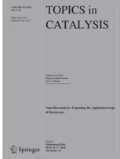Abstract
Diesel particulate filters (DPF) are indispensable parts of modern automotive exhaust gas aftertreatment systems due to the stringent emissions legislation. For a fuel-efficient control strategy, it would be beneficial to determine directly and in-operation their actual trapped soot mass. Two novel approaches—based on the electrical conductivity of trapped soot particles—emerged recently. By measuring the electrical resistance between different single walls inside the filter, the soot load is determined with local resolution. The microwave-based technique is a contactless approach that gives an integral value depending on the soot mass in the DPF. We present investigations on loading and regeneration of DPFs in a dynamometer test bench applying both methods. The results are compared with each other and correlated with the differential pressure and the soot mass. Especially the microwave-based technique has a potential for serial application.






Similar content being viewed by others
References
Twigg MV (2007) Progress and future challenges in controlling automotive exhaust gas emissions. Appl Catal B 70:2–15
Rose D, Boger T (2009) Different approaches to soot estimation as key requirement for DPF applications. SAE paper 2009-01-1262. doi:10.4271/2009-01-1262
Birkhofer T, Dittler A, Hertzberg A, Knezevic A, Plog C (2008) Device for determination of the state of a soot particle filter. European patent specification, EP 1714012 B1
Birkhofer T, Knezevic A, Mueller R, Plog C (2005) Method of operating a diesel particle filter. European patent application, EP 1564387 A1
Hagen G, Feistkorn C, Wiegärtner S, Heinrich A, Brüggemann D, Moos R (2010) Conductometric soot sensor for automotive exhausts: initial studies. Sensors 10:1589–1598
Ochs T, Schittenhelm A, Genssle A, Kamp B (2010) Particulate matter sensor for on board diagnostics (OBD) of diesel particulate filters (DPF). SAE paper 2010-01-0307. doi:10.4271/2010-01-0307
Grob B, Schmid J, Ivleva NP, Niessner R (2012) Conductivity for soot sensing: possibilities and limitations. Anal Chem 84:3586–3592
Reiß S, Spörl M, Hagen G, Fischerauer G, Moos R (2011) Combination of wirebound and microwave measurements for in situ characterization of automotive three-way catalysts. IEEE Sens J 11:434–438
Fischerauer G, Spörl M, Gollwitzer A, Wedemann M, Moos R (2008) Catalyst state observation via the perturbation of a microwave cavity resonator. Frequenz 62:180–184
Fischerauer G, Spörl M, Reiß S, Moos R (2010) Microwave-based investigation of electrochemical processes in catalysts and related systems. Tech Mess 77:419–427
Fischerauer G, Förster M, Moos R (2010) Sensing the soot load in automotive diesel particulate filters by microwave methods. Meas Sci Technol 21:035108
Sappok A, Bromberg L, Parks J, Prikhodko V (2010) Loading and regeneration analysis of a diesel particulate filter with a radio frequency-based sensor. SAE paper 2010-01-2126. doi:10.4271/2010-01-2126
Hansson J, Ingeström V (2012) A method for estimating soot load in a DPF using an RF-based sensor. Master Thesis, Linköping University, Sweden
Dunne L, Sarkar A, Kroto H, Munn J, Kathirgamanathan P, Heinen U, Fernandez J, Hare J, Reid D, Clark A (1996) Electrical, magnetic and structural characterization of fullerene soots. J Phys Condens Matter 8:2127–2141
Schejbal M, Marek M, Kubicek M, Koci P (2009) Modelling of diesel filters for particulates removal. Chem Eng J 154:219–230
Acknowledgments
The authors R.M. and G.F. are indebted to the German Research Foundation (DFG) for financial support under grant number MO 1060/6-2 and FI 956/3-2, respectively.
Author information
Authors and Affiliations
Corresponding author
Rights and permissions
About this article
Cite this article
Feulner, M., Hagen, G., Piontkowski, A. et al. In-Operation Monitoring of the Soot Load of Diesel Particulate Filters: Initial Tests. Top Catal 56, 483–488 (2013). https://doi.org/10.1007/s11244-013-0002-9
Published:
Issue Date:
DOI: https://doi.org/10.1007/s11244-013-0002-9




